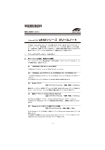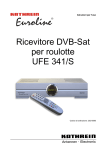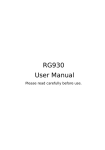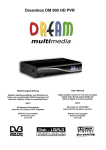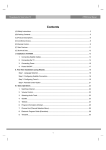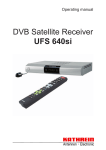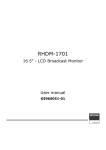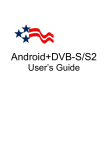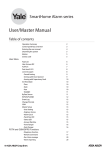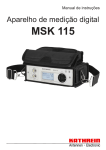Download SU980 Dream BOX
Transcript
Table of contents 1. Before initial operation of the receiver 2. Installation 3. First Time Installation (using Wizard) 4. Basic operation 5. Electronic Program Guide-EPG 6. Edit the channel list 7. Hard disk operation 8. Teletext 9. Picture-in-Picture mode (PiP) 10. Sleep timer 11. Setup 12. Service searching 13. System information 14. Switch system 15. Specifications 2 1. Before initial operation of the receiver 1.1 Safety instructions CAUTION: The lighting flash with arrowhead symbol, within an equilateral triangle, is intended to alert the user to "dangerous voltage" and to prevent from electric shock risk. Warning: To reduce the risk of electric shock, don't open the cabinet. Refer servicing to qualified personnel only. The exclamation point within an equilateral triangle is intended to alert the user to important operating and maintenance (servicing). WARNING: Do not use this STB where contact with or immerse in water is a possibility. Do not use it near flower vase, washbowls, kitchen sinks, laundry tubs, swimming pools, etc. WARNING: Do not put the candle or lamp stand on the cabinet; otherwise, there is the danger of fire. WARNING: The unit should be connected to a power supply only of the type described in the operating instructions or as marked on the unit. If you are not sure of the type of power supply (for example, 120 or 230 V) to your home, consult your local dealer or local power company. WARNING: This product installs diodes. Do not open the cabinet or touch any parts in the inner mechanism. Consult your local dealer for technical service if the opening is required. Note: To ensure proper use of this product, please read this User manual carefully and retain for further reference. Note: This product installs diodes. Do not open the cabinet to avoid the unit direct exposure to radiation. Unit Cleaning: After the unit power is turned off, you can clean the cabinet, panel and remote control with a soft cloth lightly moistened with a mild detergent solution. Attachments: Never add any attachments and/or equipment without the manufacturer consent; as such additions may result in the risk of fire, electric shock, or other personal injury. Locating: Slots and openings in the cabinet are provided for ventilation to protect it from overheating. Do not block these openings or allow them to be blocked by placing the STB on a bed, sofa, or other similar surface, nor should it be placed over a radiator or heat register. 3 Power-Cord Protection: Place the power-supply cord out of the way, where it will not be walked on. Please pay special attention to cords at plugs, convenience receptacles, and the point where they exit from the unit. Object and Liquid Entry: Never put objects of any kind into this STB through openings, as they may touch dangerous voltage points or short-out parts that could result in a fire or electric shock. Never spill any liquid on the STB. Note: Moisture may be formed on the lens In the following conditions: ¾ When the unit is suddenly moved from a cold environment or an air-condition room to a warm place. ¾ Immediately after a heater has been turned on. ¾ In a steamy or very humid room. If the moisture forms inside the unit, it may not operate properly. To correct this problem, turn on the power and wait about two hours for the moisture to evaporate. Parts Replacement: When the unit parts need to be replaced, user should make sure the service technician use the replacement parts specified by the manufacturer or having the same characteristics as the original part. Unauthorized replacement may put the unit at the risk of fire, electric shock or other hazards. Safety Check: After all the maintenances and repairs are done, user is required to request the service technician to conduct the overall safety check to ensure the machine is In the proper condition. Disposal instructions The packaging of the STB only consists of reusable materials. Please recycle if possible. This symbol on the product or on its packaging indicates that this product must not be disposed of with your other household waste. Instead, it is your responsibility to dispose of your waste equipment by handing it over to a designated collection point for the recycling of waste electrical and electronic equipment. The separate collection and recycling of your waste equipment at the time of disposal will help to conserve natural resources and ensure that it is recycled in a manner that protects human health and the environment. For more information about where you can drop off your waste equipment for recycling, please contact your local city office, your household waste disposal service or the shop where you purchased the product. Please note that empty batteries and electric waste is not to be put into the regular garbage. 4 1.2 Remote Control RCU Key Function POWER Switch the STB ON and OFF. MUTE Silence the audio temporarily. TEXT Display the teletext information of the current channel, if the channel provides teletext data. SUBT Display the subtitle of the current channel, if the channel provides subtitle. AUDIO Display the audio track option to choose from (e.g. ACS, Stereo). HELP Display major important operation methods of STB. This provides users with a quick guide of using STB. TV Display the TV Channel list. Recording Display instantly the recording menu. Stop Stop the playing of a recording and go to the live mode. Radio Display the Radio channel list. Play Play the selected file (e.g. recording) at normal speed. Pause Pause the live program or recording play. Fast Rewind Fast rewind at up to 128 times faster than at normal speed (x2 / 4 / 8 / 16 / 32 / 64 / 128). Fast Forward Fast forward at up to 128 times faster than at normal speed (x2 / 4 / 8 / 16 / 32 / 64 / 128). Color Keys (Red,Green,Yell Each key is assigned to a specific function which may be different in each menu. ow,Blue) Numeric Keys Enter a channel number or numbers required to be input according to menu options. Navigation Keys Navigate up/down and left/right on the menu options. Up/down keys are used to call up the channel list. OK Confirm the selected menu option. EXIT Exit the current menu option into the live mode, or switch one step back of the menu. HOME Instantly move to the top of the menu list. END Instantly move to the bottom of the menu list. Volume + / - Adjust the audio volume. Bouquet +/- jump back and forth between the bouquets INFO Display the information in different status. Recording List Display the list of recordings stored on the HDD. 5 1.3 Product Descriptions Front Panel Display Display the current menu information. Dial Switch Scroll up and down on the current menu list. Push and confirm the selection. USB Host Connect to the USB memory stick or external HDD. Smartcard reader slot Smartcard slot is provided. CI Module slot CI module slot is provided. Rear Panel LNB 1 In / LNB 2 In Two Satellite cables can be connected. ANT IN/ANT OUT Digital terrestrial signal input and loop out Coaxial Connect to a digital audio system using coaxial cable. Video output Connect to TV using RCA cable. Audio output Connect to TV using RCA cable Component (YPbPr) Connect to TV using a component cable HDMI Connect to TV using a HDMI cable for both audio and video signals Ethernet Connect the PC or another STB. USB Connect to the USB memory stick or external HDD. RS232 RS232 data port is provided. On/Off Switch Power on/off 6 2. Installation This chapter will guide you through the whole installation process of STB. Please read each section carefully to make sure that the system runs properly. 1. Connecting Satellite Cables STB is integrated with two satellite tuners, and the first step is to connect the satellite cable(s) to STB. In order to gain optimal signal quality, you can choose either of the following connection methods depending on the equipment you have. A. Two Separate Satellite Cables In case you have two separate satellite cables providing different broadcast signals, you can configure LNB 1 Input and LNB 2 Input independently. 2. Connecting the TV STB provides a variety of audio/video connection methods. A. Connecting TV via HDMI cable For the sake of the best picture quality, especially for digital TV, HDMI connection is recommended. Most HDTVs have HDMI connectors to ensure the highest picture quality. In the rear panel of STB has a HDMI connector for this purpose. Connect your TV to STB using a HDMI cable as follows. B. Connecting TV via Component Cable The second recommend TV connection for digital TV is via component cable (YPbPr). However, unlike the HDMI connection which delivers audio and video signal at the same time, YPbPr connection requires additional audio connection either via RCA cable (Stereo L/R) or S/PDIF as follows. C. Connecting TV via RCA (Video) Cable STB provides Composite video connection as well. Composite cable has normally three connectors at the both end; one Video (Yellow) and two Audio (White / Red). Connect your TV to STB as follows: 7 3. First Time Installation (using Wizard) The starting wizard helps you with the basic setup of your STB 3.1 Video output selection You will see different video output modes for roughly 10 seconds, after you have connected and switched on your STB. Once you see a clear picture on your TV screen press the OK-Button to select it. If you prefer a different output than the selected one you can use the Navigations-Buttons up/down and the OK-Button to select it. You can choose from the following video output options: HDMI using a HDMI cable CVBS using a component cable YPbPr (YUV) using a component cable Select your desired option with the Navigation-Buttons up and down. Press the OK-Button to activate. You are taken to the next step. You can now select the video mode. The possible options strongly depend on the video output mode you have selected in the step before. Select your desired option with the Navigation-Buttons up and down. Press the OK-Button to activate. You are taken to the next step. Finally you can adjust the screen using some test screens. Select your desired option with the Navigation-Buttons up and down. Press the OK-Button to activate. The video outputs should now be configured. 8 3.2 Language selection Select your desired language with the Navigation-Buttons up and down. Press the OK-Button to activate. The starting wizard takes you through the basic setup of your STB. Press the OK-Button on your remote control to get to the next step. You will be asked if you want to set the basic settings for your STB now or if you want to quit the start wizard. Use the Navigation-Buttons up and down to select your desired option and press the OK-Button to activate your selection. If you choose “User wizard to setup basic features” you will be taken to the menu for the tuner configuration. 3.3 Tuner setup Detailed information about the tuner setup can be found in chapter 12.1 DVB-S Tuner configuration. 3.4 Default services list/Service scan Depending on your tuner configuration in the previous step, you might be offered to install default services lists. Otherwise you will be asked to perform a service scan. Detailed information about the service scan can be found in chapter 12.2 Automatic scan. 9 3.5 Parental Control Refer to section 6.8 Parental control for further information about this feature. 4. Basic operation 4.1 Turning your STB on and off Use the Power-Button to turn your STB on and off. To put your STB into Standby-Mode press the Power-Button on your remote control or press directly on your STB. The current time will be shown in the STB’s OLED-Display. Holding down the Power-Button on your remote control for three seconds will put your STB into the Shutdown Mode. You can also put your STB into Shutdown Mode by using the OSD main menu. Choose the Option “Standby / Restart” in the OSD main menu and navigate to “Shutdown” option afterwards. Pressing the OK-Button will put your STB into the Shutdown Mode. Alternatively you can push down the Power-Button on your STB for 5 seconds. If no OSD Menu is visible on the screen, your STB will also put into Shutdown Mode. All your settings will be saved now and your STB goes into Shutdown Mode afterwards (saves energy!). 10 4.2 Service selection Pressing the Left/Right-Buttons on your STB remote control will take you to the previous or next service. Pressing the 0 on the Numeric-Keypad will enable you to skip back and forth between the two most recently watched services. This feature is quite useful during commercial breaks since it enables you to watch another channel and quickly check if your movie is back on. Using the Navigation-Buttons left/right you can switch to the 20 last viewed services. 4.3 Changing channel using the service list Press the Up/Down-Buttons on your remote control to activate the service list. Use the Navigation-Buttons up/down to select the desired service and press the OK-Button to change to the selected service. 4.4 Controlling the volume The Volume +/- Buttons controls the volume of the audio. Pressing + will make turn it up and pressing - will turn it down. Pressing the MUTE-Button mutes the volume. A crossed speaker symbol will appear on the screen. 4.5 Changing the audio track Pressing the Audio-Button in TV or Radio Mode will reveal the “Audio” menu of the selected service. Use the Navigation-Buttons up and down to move to desired audio track. Press the OK-Button to select. The contents of this menu will vary from service to service. Press the Navigation-Buttons up and down to toggle AC3 downmix on and off. 4.6 Sub Services The green dot in the Infobar appears if the selected station transmits sub services. Pressing the green Options-Button in TV or Radio mode will reveal the sub services menu. 11 Use the Navigation-Buttons up and down to move to one of the sub services. Press the OK-Button to select. 4.7 TV/Radio switching Press the RADIO-Button to activate the RADIO-Mode. 4.8 Teletext Use the Text-Button to enter the Teletext and the Exit-Button to leave. 4.9 Subtitles Press the Menu-Button to enter the main menu. Select “Subtitles” and press the OK-Button. A list with the available subtitles will show up. Use the Navigation-Buttons up and down to select a desired subtitle and press the OK-Button to activate. The screenshot on the left shows you an example of how a subtitle looks. To deactivate subtitles process as described previously, just select deactivate subtitles instead of a subtitle page. Note: Keep in mind that not every station offers subtitles. If no subtitles are available, the subtitle list will stay empty. 4.10 Infobar The Infobar appears and disappears by pressing the OK-Button once, if no OSD menu is shown on your screen or when you change channels. The Infobar shows all necessary Information about the selected service. 5. Electronic Program Guide - EPG By pressing the INFO-Button in TV-Mode you are supplied with detailed information about the current show and by pressing the Right-Button afterwards about the next show. Press the yellow Options-Button to activate the “Channel-EPG” (See chapter 5.1) and pressing the blue Options-Button activates the “Multi-EPG“(See chapter 5.2). The STB automatically searches for similar broadcasts in the background. If one or more similar broadcasts are found, the label “Similar” will appear in the red window. 12 Pressing the red Options-Button opens a listing of similar broadcasts. By pressing the green Options-Button you can set a timer for this to rerun. For additional information about recording by timer please see chapter 7.2.3 Recording by timer. 5.1 Single-EPG In this view you are supplied with detailed information about the currently selected channel’s programming. By pressing the yellow Options-Button your can sort the “Single-EPG” alphabetically or by time. You can also access this view by pressing the Info-Button for about 2 seconds. The Navigation-Buttons up/down to open the services list and then press the Info-Button. This way you can very quickly and easily access the Single-EPG of every service. 5.2 Multi-EPG Use the blue and yellow Options-Buttons to switch between the present, next and more views. Pressing the green Options-Button will give you the possibility to automatically copy the start and end time of the selected show into a recording timer. If you have set the “Multi bouquets” option to “yes” (see chapter 11.2) a selection of you bouquets will appear. Select the bouquet of which you want the Multi-EPG view. This view shows the currently airing shows on the services listed in the left column. A progress bar showing the progress of the currently airing show is placed next to the service’s name. Using the Navigation-Buttons up and down you can select a service, just like in the service list, and change to the selected service by pressing the red Options-Button 5.3 Graphical Multi-EPG You have another option to view the EPG of different services and successive shows. The Graphical Multi-EPG displays the EPG overview of the upcoming hours (can be set to 1-5 hours with the Buttons 1-5 on the Numeric-Keypad) for the chosen bouquet. Using the Navigation-Buttons up/down/left/right you can browse the shows. More detailed information about the selected show is displayed at the bottom part of the EPG. You can directly set a timer for the selected show, by just pressing the green Options-Button. 13 6. Edit the channel list What is a bouquet? A bouquet can be thought of something like a folder. Every channel equals a page in this folder and the pages are sorted into categories. Note: You can only delete channels in the favorites view! 6.1 Adding a bouquet To be able to add a bouquet you have to set the “Allow multiple bouquets” option to yes. Pressing the Up/Down-Buttons on your remote control to activate Press the blue Options-Button to switch to the bouquet view The “Channel list menu“will open up by pressing the Menu-Button. Navigate to the option “add bouquet“. Use the Numeric-Keypad on your remote control to enter the name for the new bouquet. The according letters are printed on button. The Mute-Button deletes a character. Press the OK-Button to add the new bouquet to your favorites list. You will be taken back to the "Channel list menu". 14 6.2 Add a service to favorites If you want to add a service to your Favorites-view, you can choose from services in the All-, Satellites- and Provider-views. You can switch views by pressing the red, green, yellow and blue Options-Buttons. At this point we only describe the process from the All-Bouquet since it is the same for the others. Press the Up/Down-Buttons on your remote control to activate the service list. Press the red Options-Button to change to the All view. Use the Navigation-Buttons up/down to select the desired service and press the MENU-Button to open the “Channel list menu”. Navigate to the option “add service to bouquet”. If you are using more than one bouquet this option is named “add service to bouquet” instead and you will get a list of your bouquets afterwards. You can choose to which bouquet you want to add the currently selected service. If you are using only one bouquet which is the factory default, the service will be added to you favorites list. 6.3 Adding multiple services to a bouquet You can select multiple services from the All-view to be added to the currently selected bouquet. Press the Up/Down-Buttons on your remote control to activate the service list. Use the Bouquet +/- Buttons to switch to the desired bouquet. As an alternative you can press the blue Options-Button and select the desired bouquet. After that select a service and switch to it by pressing the OK-Button. The “Channel list menu“will open up by pressing the Menu-Button. Navigate to the option “enable bouquet edit“. The All view will Open up. 15 All services that are in the selected bouquet are highlighted red. Use the Up/Down-Buttons to navigate to a desired service and press the OK-Button to select. The service will be highlighted red. Using this method you can select additional services that you want to add to the bouquet. Once you have selected all services that you want to add, by pressing the Menu-Button, the “Channel list menu“will open up. Choose the “End bouquet edit“option. All highlighted services will be added to the bouquet that you selected at the beginning. If you are only using one bouquet, which is the default setting, the selected services will be added to you favorites list. 6.4 Remove a service from favorites Press the Up/Down-Buttons on your remote control to activate the service list. Use the Navigation-Buttons up/down to select the desired service and press the MENU-Button to open the “Channel list menu”. Navigate to the option “remove service”. The selected service will be deleted from your favorites list. 6.5 Moving a service to favorites Press the Up/Down-Buttons on your remote control to activate the service list. Use the Navigation-Buttons up/down to select the desired service and press the MENU-Button to open the “Channel list menu”. Navigate to the option “enable move mode” and press the 16 OK-Button. Use the Navigation-Buttons up/down to select the service that you want to move and press the OK-Button. The service will be highlighted red. Use the Navigation-Buttons up and down to move the service to the desired position. Press the OK-Button to release the service and thus placing it at its new position. You can move services as long as the move mode is activated. To disable the move mode press the MENU-Button to get into the “Channel list menu” and chose the option “disable move mode” by pressing the OK-Button. 6.6 Adding a marker to favorites You have the option to add makers within the favorite bouquets. Press the Up/Down-Buttons on your remote control to activate the service list. Use the Bouquet +/- Buttons to switch to the desired bouquet. As an alternative you can press the blue Options-Button and select the desired bouquet. Select a service. The marker will be added above the selected service. By pressing the Menu-Button the "Channel list menu" will open up. Navigate to the option "add marker". Use the Numeric-Keypad on your remote control to enter the name for the new bouquet. The according letters are printed on button. The Mute-Button deletes a character. 17 Press the OK-Button, adding the marker to your favorites list. You will be taken back to the "Channel list menu". As an example we have added two markers as shown in the left of the picture. Use the Arrow-Left and Arrow-Right-Buttons to jump between those two markers. 6.7 Parental control Parental control makes it possible to lock selected channels. If no OSD menu is visible on your screen, press the Menu-Button to open the main OSD menu. Navigate to the option “Setup” and press the OK-Button to select. 1. Navigate to the “Parental lock“option and press the OK-Button. The “Parental control setup” menu will open up. Set the “Enable parental control” option to yes. Under the “Parental control type” option you can choose between a blacklist and a white list. White list means that all channels being not in the parental control list will be locked. Backlist means that all the channels in the parental control list will be locked. If you want to change the pincode, select the “Change service pin” option and press the OK-Button. You have to enter the new pincode twice to ensure you didn’t make any typing errors. Now you will be prompted to enter the old pincode and then the new one. You will see this notice that the pincode has been changed. Press the OK-Button to get back into the Parental control menu. 18 If the entered pincode was false, you will see this notice. Press the OK-Button to get back into the “Change service pin” menu and to enter the correct new pincode twice. Now select the “Edit services list” option and press the OK-Button. Use the Navigation-Buttons up/down to select the first letter of the channel that you want to lock or allow and press the OK-Button. In this example we decided to lock the service called “ProSieben”. Accordingly we selected the “P” as the first letter. The Parental control services Editor will open up. All services beginning with the letter “P” are shown. Select “ProSieben” and press the OK-Button. A symbolized padlock will appear in front of the channel letting you know that it can only be watched when the right pincode is entered. 19 If you have selected white list under the “Parental control type” then this channel will be the only one that can be viewed without entering the right pincode. Protecting the parental lock setup Additionally you have the option to protect the parental control menu using a pincode. Setting the “Protect setup” option to yes, you will only be able to change parental control setting after you have entered the correct pincode. Once you entered the wrong pincode three times in a row you have to wait 15 minutes before you can try again. Note: You can use two different pincodes to protect the setup and the service list. 7. Hard disk operation 7.1 Initialization If no OSD menu is visible on your screen, press the Menu-Button to open the main OSD menu. Navigate to the option “Setup” and press the OK-Button to select. 1. Navigate to the option “System” and press the OK-Button. The “System” menu will open up. Navigate to the option “Hard disk” and press the OK-Button Navigate to the “Hard disk setup” option and press the OK-Button. Navigate to the desired HDD option and press the OK-Button. If you have installed another hard disk, this option will differ from the one depicted! By pressing the red Options-Button you will initialize (format) the hard disk. After you confirm the safety question the initialization process starts. WARNING: All data stored on the HDD will be lost. 20 7.2 Recording 7.2.1 Instant recording. Press the Record-Button. You have five available options: -Add recording (indefinitely) -Add recording (stop after current event) -Add recording (enter recording duration) -Add recording (enter recording end time) -Don't record Use the up/down-Buttons to navigate to your desired selection and press the OK-Button to select. An ongoing recording is indicated by a flashing symbol in the info bar. During the recording you can watch another service, view a previously recorded movie or add an additional recording. Press the Up/Down-Buttons on your remote control to activate the service list. The recording continues in the background. If all tuners are used for recording or by the Picture- in-Picture mode, and you are trying to access a service that is not on one of the recorded transponders, you will get the “No free tuner” message. 7.2.2 Stop recording Switch to the service of which recording you want to stop. Press the Record-Button, select the "Stop recording" option and press the OK-Button to select. If you only have one active recording, it will be stopped immediately. If more than one recording is active, you will be given the choice of which recording you want to stop. 7.2.3 Recording by timer With the help of a timer you can record shows (if you have a hard disk installed). You are offered two different ways to program a timer, the manual way of via the EPG. If no OSD menu is visible on your screen, press the Menu-Button to open the main OSD menu. Navigate to the option “Timer” and press the OK-Button to select. The “Timer“ menu will be seen. Pressing the red Options-Button will delete a timer. The green Options-Button adds a timer, the yellow Options-Button toggles active on and off (only possible in waiting status) and the blue Options-Button removes finished timers from the list. 21 If you pressed the blue Options-Button you will be asked if you really want to delete the finished timer. Use the Navigation-Buttons up and down to select. Press the OK-Button to activate. Manual programming Press the green Options-Button to add a new timer. You can choose between two different timer types. “Record“ to record the desiredshow or “Zap“ to automatically switch to the service. As repeat type you can choose between “once” and “repeated“. The repeat type “repeated” offers you the following options: • Daily • Weekly with choice of weekday • Monday through Friday • User defined For all four options you can set a date for the first execution of the timer 7.2.4 Timeshift Once you started an instant recording, you can fast-forward and rewind while recording as long as you have already recorded at least 1 minute long. Press the PLAY/PAUSE-Button to pause the screen (video and audio will pause). The recording will continue in the background. Press the PLAY/PAUSE-Button again to resume watching. This way you won’t have to miss anything ever again if you quickly have to catch a phone call. The Timeshift-Mode can be exited by pressing the Stop-Button. To ensure the Timeshift-Mode is not stopped by accident you will be asked if you want to quit the Timeshift-Mode. Use the Navigation-Buttons up and down to select. Press the OK-Button to activate. 7.3 Watch a recording Press the PVR-Button to get to the selection of recordings. Use the Navigation-Buttons up and down to select a recording. Press the OK-Button to start playing it. Press the Navigation-Buttons up and down or the PVR-Button to get back to the list of recordings. The following speeds for spooling in a recording are available: • Forward (Fast Forward-Button): 2x,4x,8x,16x,32x,48x,64x,128x • Back (Rewind-Button): 8x, 16x, 32x, 48x, 64x, 128 xs Every press on the button increases the speed by one step. 22 7.4 Delete a recording Press the PVR-Button to get to the selection of recordings. Use the Navigation-Buttons up and down to select a recording. Press the Menu-Button. Use the Navigation-Buttons up and down to select “Delete” and press the OK-Button. You will be asked if you want to delete the recording. As a control feature the name of the recording is displayed as well. Choose “Yes” and you will be taken back to the selection of recordings 8. Teletext You are in the TV or radio mode, press the Text-Button to enter the Teletext. Keep in mind that not every station transmits Teletext! Teletext - regular navigation: If you are viewing any Teletext page you can enter the interactive mode by pressing the OK-Button. Use the Navigation-Buttons to select a text page number and press the OK-Button to call this page. You don’t need to type in a text page number in this mode, but it is still possible. Press the EXIT-Button to exit. 9. Picture-in-Picture mode (PiP) The STB has a so called PiP-Function. With PiP you can display a small TV picture on top of the main big TV picture. Press the blue Options-Button and select the “Activate Picture in Picture“option. The main TV picture is now additionally displayed as a small PiP 23 in the upper right corner of your screen and the last watched service is displayed in the main big TV picture. In PiP mode you will always hear the sound from the main TV picture. If you now switch services as you are used to, the main TV picture will change, but the PiP stays. By pressing the blue options-Button you can choose between the following options: 1. Disable Picture in Picture: (blue Options-Button) Choose the option to turn the PiP mode off. The little PiP will disappear and only the main TV picture is displayed on your screen. 2. Move Picture in Picture: (green Options-Button) Choose the option to move or resize the small PiP. You can move the position of the small PiP by using the Navigation-Buttons up/down and left/right. Use the Bouquet +/- Buttons to resize the small PiP. Press the Exit-Button to discard your changes or the OK-Button to save the settings and return to the current TV show. 3. Swap services: (yellow Options-Button) Choose the option to swap the main TV picture and the small PiP. The small PiP becomes the main TV picture and vice versa. 10. Sleep timer Using the sleep timer you can put your STB into standby or turn it off after a predetermined amount of time. Press the blue Options-Button or open the main menu -> Standby/ Restart and select the option “Sleep Timer”. Shutdown STB after: Set the number of minutes after you wish the predetermined shutdown action to be executed. Timer status: Set this option to “enabled” to activate a set sleep timer or to “disabled” to deactivate a set sleep timer. Press the red Options-Button to change the status. Sleep timer action: Select “Deep Standby” to completely turn off you STB or “Standby” to put it into standby mode. Press the green Options-Button to toggle the sleep timer action. 24 Ask before shutdown: If this option is set to “Yes” a safety window will appear once the sleep timer is executed asking you if you really want to turn off your STB. Press the yellow Options-Button to toggle this option. Once you have set all options to your liking press the OK-Button to save your settings. A short note will tell you that the sleep timer has been activated. 11. Setup 11.1 Language If no OSD menu is visible on your screen, press the Menu-Button to open the main OSD menu. Navigate to the option “Setup” and press the OK-Button to select. 1. Navigate to the option “System” and press the OK-Button. • The “System” menu will open up. 2. Navigate to the option “Language…” and press the OK-Button. • The “Language” menu will open up Select your desired language with the Navigation-Buttons up and down. Press the OK-Button to activate. 11.2 A/V Settings If no OSD menu is visible on your screen, press the Menu-Button to open the main OSD menu. Navigate to the option “Setup” and press the OK-Button to select. 1. Navigate to the option “System” and press the OK-Button. • The “System” menu will open up. 2. Navigate to the option “A/V settings…” and press the OK-Button. 11.3 Network If no OSD menu is visible on your screen, press the Menu-Button to open the main OSD menu. Navigate to the option “Setup” and press the OK-Button to select. 1. Navigate to the option “System” and press the OK-Button. • The “System” menu will open up. 2. Navigate to the option “Network…” and press the OK-Button. 25 11.3.1 Integrated Ethernet Select “Integrated Ethernet“and press the OK-Button. Select the “Adapter settings“option and press the OK-Button. Use the Navigation-Buttons and the Numeric-Keypad to change the settings. Use interface: This option toggles the integrated Ethernet interface on and off. Use DHCP: If set to “yes“your STB will get its IP from a DHCP server. If you are using a router to access the internet you usually have a DHCP server. Disable this option to set a static IP address. Manually setting an IP address These settings are only needed if you have selected “no“ on the “Use DHCP“ option before. IP Address: You can assign any IP address to you STB. The only expectation is the 192.168.0.1 IP since it usually is reserved for you internet router and should therefore not be used. Network test The network test will assist you in finding possible sources of error in your network configuration. Press the green Options-Button to start the test or to repeat it. Press the yellow Options-Button to abort the test. Once the test has finished you can get additional information and help to every sub-item of the test. Use the Navigation-Buttons up/down to select the item and press the OK-Button. 26 Restart network Reboot the network configuration of your STB. 11.3.2 Integrated wireless (WLAN) Select “Integrated Wireless“and press the OK-Button. You can either use the “Scan wireless networks“option to look for any existing wireless access points or manually enter all the required settings. Automatic Select the “Scan wireless networks“option and press the OK-Button. A window with all available networks will pop up. Select the network that you wish to connect to and press the green Options-Button. A window for the adapter settings will open. Use the Navigation-Buttons and the Numeric-Keypad to change the settings. Manual Select the “Adapter settings“option and press the OK-Button. A window for the adapter settings will open. Use the Navigation-Buttons and the Numeric-Keypad to change the settings. Adapter settings Use interface: This option toggles the integrated Ethernet interface on and off. Use DHCP: If set to “yes“your STB will get its IP from a DHCP server. If you are using a router to access the internet you usually have a DHCP server. Disable this option to set a static IP address. In this case you do not need to make any further changes. If set to “no“ you need to manually set an IP address. Refer to chapter 11.3.1 to section “Manually setting an IP address“ for further information. 27 11.4 Skin Selecting another skin will change the looks of your OSD (On-Screen-Display).If no OSD menu is visible on your screen, press the Menu-Button to open the main OSD menu. Navigate to the option “Setup” and press the OK-Button to select. 1. Navigate to the option “System” and press the OK-Button. The “System” menu will open up. 2. Navigate to the option “Skin” and press the OK-Button. The “Skin” menu will open up. To fully activate the skin the system needs to be restarted. Use the Navigation-Buttons up/down to select your desired option and press the OK-Button. 11.5 Factory reset Press the Menu-Button to open the main OSD menu. Navigate to the option “Setup” and press the OK-Button to select. Navigate to the option “Factory reset” and press the OK-Button. You are asked if you really want to reset all you settings to the factory defaults. If you choose “yes“all you configuration data including bouquets, satellite data, etc. will be lost. Your STB will automatically reboot afterwards. 12. Service searching 12.1 DVB-S2 Tuner configuration Press the Menu-Button to open the main OSD menu. Navigate to the option “Setup” and press the OK-Button to select. 1. Navigate to the option “Service searching” and press the OK-Button. The “Service searching” menu will open up. 2. Navigate to the option “Tuner configuration” and press the OK-Button. The “Choose Tuner“ menu will open up. Use the Navigation-Buttons up and down to select the DVB-S2 tuner and press the OK-Button. 28 12.1.1 Single satellite – direct connection (DVB-S2) Use this type of configuration if you want to receive a single satellite with a Single Universal LNB. The coax cable is directly connected from you STB to the LNB. Please read the section 12.1.1 DVB-S2 configuration to learn how to get into this menu. The “Reception settings” menu will open up. Use the up/down-Buttons to navigate to the “Mode” option and use the left/right-Buttons to select “Single”. Use to the Navigation-Buttons left and right to select the desired satellite and press the OK-Button. You are taken back to the “Choose tuner“menu. If you have trouble with “Tune failed“messages please set the “Send DiSEqC only on satellite” changes to “yes“. 12.1.2 Two satellites via Toneburst A/B (DVB-S2) Use this type of configuration if you want to receive two satellites from one LNB each. It does not matter if you use one or two dishes to achieve this. Connect the two coax cables form the two LNBs to a so-called Tone-burst switch and connect the coax cable from the Tone-burst switch to your STB. Please read the section 12.1 DVB-S2 configuration to learn how to get into this menu. The “Reception settings” menu will open up. Use the up/down-Buttons to navigate to the “Mode” option and use the left/right-Buttons to select “Tone-burst A/B”. For Port A and Port B select the desired satellites just as described in the Single satellite – direct connection section. Make sure you know which satellite is connected to which input on the Tone-burst switch. If you do not find any services in the transponder scan later, exchange the two satellites in this list and try again. Press the OK-Button to save your settings. 29 12.1.3 Two satellites via DiSEqC A/B (DVB-S2) Use this type of configuration if you want to receive two satellites from one Twin Universal or Quad Universal LNB. It does not matter if you use one or two dishes to achieve this. In this case the LNBs are connected to a so-called Multi-switch from which the signal is via coax cabled to the satellite receivers (STB) in your household. Please read the section 12.1 DVB-S/DVB-S2 configuration to learn how to get into this menu. The “Reception settings” menu will open up. Use the up/down-Buttons to navigate to the “Mode” option and use the left/right-Buttons to select “DiSEqC A/B”. For Port A and Port B select the desired satellites just as described in the Single satellite – direct connection section. Make sure you know which satellite is connected to which input on the Tone-burst switch. If you do not find any services in the transponder scan later, exchange the two satellites in this list and try again. Press the OK-Button to save your settings. If you have trouble with “Tune failed“ messages please set the “Send DiSEqC only on satellite change“ and “Set voltage and 22KHz“ to “yes“. 12.1.4 Four satellites via DiSEqC A/B/C/D (DVB-S2) Use this type of configuration if you want to receive four satellites from one Single Universal or Twin Universal LNB for four or eight parties. It does not matter if you use one or two dishes to achieve this. In this case the LNBs are connected to a so-called Multi-switch from which the signal is via coax cabled to the satellite receivers (STB) in your household. Please read the section 12.1 DVB-S/DVB-S2 configuration to learn how to get into this menu. Four satellites via DiSEqC A/B/C/D (DVB-S) The Reception settings menu will open up. Use the up/down-Buttons to navigate to the Mode option and use the left/right-Buttons to select DiSEqC A/B/C/D. 30 For Ports A, B, C and D select the desired satellites just as described in the Single satellite – direct connection section. Make sure you know which satellite is connected to which input on the Tone-burst switch. If you do not find any services in the transponder scan later, exchange the two satellites in this list and try again. Press the OK-Button to save your settings. 12.1.5 Tuner B setup (DVB-S/DVB-S2) The same setup possibilities that applied for Tuner A also apply for Tuner B. There are some additional configuration options. Equal to socket A: Use this setting if Tuner B should use the same settings as Tuner A. Loop through to socket A: Use this option if the LNB1 out should be connected to the LNB2 in. You do not need an external connection cable. 12.2 DVB-T Tuner configuration If no OSD menu is visible on your screen, press the Menu-Button to open the main OSD menu. Navigate to the option “Setup” and press the OK-Button to select. 1. Navigate to the option “Service searching” and press the OK-Button. The “Service searching” menu will open up 2. Navigate to the option “Tuner configuration” and press the OK-Button. The “Choose tuner” menu will open up. 3. Use the Navigation-Buttons up and down to select the DVB-T Tuner and press the OK-Button. The “Reception settings” menu will open up. Choose your region by pressing the Navigation-Buttons left/right. If you have connected an active antenna and you want to run the antenna without it’s original power supply set the “Enable 5V for active antenna” option to “On”. Press the OK-Button to save your settings. 12.3 Automatic scan If no OSD menu is visible on your screen, press the Menu-Button 31 to open the main OSD menu. Navigate to the option “Setup” and press the OK-Button to select. 1. Navigate to the option “Service searching” and press the OK-Button. The open up. “Service searching” menu will 2. Navigate to the option “Automatic scan” and press the OK-Button. The “Automatic scan” menu will open up. 3. Use the Navigation-Buttons up and down to select the DVB-T Tuner and press the OK-Button. Set the “Clear before scan” option to “Yes” if you want to delete all services before the scan starts. The scan is done once you see this menu.It shows how many channels were found during the scan.Press the OK-Button to close this menu. 12.4 Manual scan If no OSD menu is visible on your screen, press the Menu-Button to open the main OSD menu. Navigate to the option “Setup” and press the OK-Button to select. 1. Navigate to the option “Service searching” and press the OK-Button. The “Service searching” menu will open up. 2. Navigate to the option “Manual scan” and press the OK-Button. Use the Navigation-Buttons left/right to select the tuner on which you want to run the manual service scan. All other options can be changed by using the Navigation-Buttons left/right and Press the OK-Button to start the manual scan. 13. System information 13.1 Service If no OSD menu is visible on your screen, press the Menu-Button to open the main OSD menu. Navigate to the option “Information” and press the OK-Button to select. Navigate to the option “Service” and press the OK Button. 13.2 About (Hard- and Software) If no OSD menu is visible on your screen, press the Menu-Button to open the main OSD menu. Navigate to the option “Information” and press the OK-Button to select. The “Information” menu will open up.Navigate to the option 32 “About…” and press the OK-Button. This window shows all relevant information about the Hard- and Software of your STB. Press the OK-Button to close this menu. 14. Switch system STB have Enigam2 and Android duplex system, you can switch between them. If no OSD menu is visible on your screen, press the Menu-Button to open the main OSD menu. Navigate to the option “Go to Android” and press the OK-Button to select. The “Really switch system now?” Information menu will open up. Navigate to the option “yes” and press the OK-Button switch to android system. When you in the android system, you can also switch the system to Enigam2.Press the “Home” button to open the main OSD menu. Navigate to the option “TV” and press the OK-Button to select. 33 The “system will reboot and switch to TV” Information menu will open up. Navigate to the option “OK” and press the OK-Button switch to Enigma2 system. 34 15. Specifications STB Specifications Front Panel OLED Display Indicates the Various Status of the STB Smart card slot 1 Common Interface 1 USB 2.0 1 Key Rear Panel Multi-functional dial switch Power switch 1 Sat-IF input Video output (analogue) 2 x F-type socket 3 x Cinch socket (YPbPr)/1 x Cinch-socket Video/audio output (digital) 1 x HDMI Audio output (analogue) 2 x Cinch socket Audio output (digital) Standard optical (SPDIF) USB Power 2 x USB 2.0 Ethernet 1 RS 232 1 Mains voltage 100-240/50-60 V/Hz Power consumption (Max./operation/standby) RF 30/20/<1 W RF range 950-2150 MHz Modulation, FEC, de-multiplexer Video DVB-S/DVB-S2 standard Video resolution CCIR 601 (720 x 576 lines), 576p, 720p, 1080i Video decoding MPEG-2, MPEG-4 compatible Input data rate 2-45 MSymb/s S/N Decoding Decoding > 53 dB AC 3, MPEG-4 (AAC-HE), MPEG-1, Layer 1, 2 and 3 Sampling rate 32/4.1/48 kHz S/N LNB LNB supply (horiz. /vert.) Control signal General > 65 dB 14/18; Max. 400 V/mA 22kHz ; Tone Burst ; DiSEqCTM1.0/1.1/1.2 Dimensions (W x H x D) Weight (without HDD) 35 www.golden-media.net




































